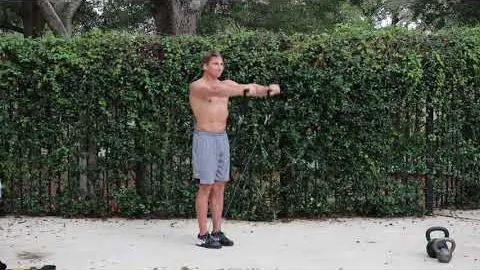
Resistance Band Front Raise is a highly effective exercise that targets the shoulders and upper body. By incorporating this exercise into your workout routine, you can significantly improve your overall upper body strength and stability. In this article, we will provide an in-depth description and step-by-step guide to perform the Resistance Band Front Raise exercise, its benefits, precautions, and variations.
The Resistance Band Front Raise offers numerous benefits for individuals of all fitness levels. Some of the key benefits include:
Shoulder Strength: The primary focus of this exercise is to strengthen the shoulder muscles, specifically the anterior deltoids. This leads to improved shoulder stability and better posture.
Upper Body Conditioning: Resistance Band Front Raise engages other upper body muscles including the trapezius, biceps, and triceps. These muscles work together, resulting in enhanced overall upper body strength.
Increased Range of Motion: This exercise helps to improve shoulder flexibility and increases the range of motion. It can be particularly beneficial for those involved in sports that require overhead movements.
Muscular Endurance: Performing the Resistance Band Front Raise with controlled repetitions and sets can help increase muscular endurance over time.
Follow these step-by-step instructions to correctly perform the Resistance Band Front Raise exercise:
Anchor the Band: Begin by securely anchoring the resistance band at waist height, either by wrapping it around a sturdy post or using door anchor attachments.
Stand Tall: Stand with your feet shoulder-width apart, maintaining good posture throughout the exercise. Hold the resistance band handles in each hand, palms facing down, with your arms extended in front of your thighs.
Engage Your Core: Activate your core muscles by drawing your belly button towards your spine. This will provide stability during the exercise.
Maintain Proper Grip: Keep your hands relaxed, gripping the resistance band handles firmly but not excessively, allowing for fluid movement.
Begin the Exercise: Exhale and slowly lift your straight arms forward and upward, keeping them parallel to the ground. Focus on engaging your shoulder muscles and maintaining a controlled movement.
Squeeze Your Shoulders: At the top of the movement, pause momentarily, and squeeze your shoulder muscles. This will intensify the contraction and provide additional benefit.
Lower the Resistance Bands: Inhale and slowly lower your arms back to the starting position, maintaining control throughout the movement. Avoid any jerking or rapid motions.
Repeat: Perform the desired number of repetitions, typically 10-15, for optimal results. Start with a weight resistance level that challenges you without compromising form.
To ensure safety and maximize the effectiveness of the Resistance Band Front Raise exercise, follow these precautions and tips:
Here are a few variations of the Resistance Band Front Raise exercise to challenge your muscles in different ways:
Single Arm Resistance Band Front Raise: Perform the exercise with one arm at a time, alternating between arms. This helps to improve muscle symmetry and balance.
Seated Resistance Band Front Raise: Perform the exercise while seated on a stability ball or chair. This variation provides additional stability and stability challenges.
Resistance Band Lateral Raise: Instead of lifting your arms straight in front of you, perform the exercise by lifting them to the side, targeting the lateral deltoids and upper back muscles.
The Resistance Band Front Raise is an effective exercise for developing shoulder strength, upper body conditioning, and increasing range of motion. Incorporate this exercise into your regular workout routine to achieve well-rounded upper body strength and stability. Remember to start with a comfortable resistance level and gradually progress as you gain strength. As with any exercise, practicing proper form and technique is crucial to prevent injury and maximize results. So grab your resistance bands and start raising your fitness level to new heights!
If you're looking for a gym, fitness club or yoga studio, you've come to the right place.
You can find information about gyms in your area. Browse catalog of gyms and find gyms with classes which are you looking for.
On gym page you can find simple information like address, phone or website. You can find list of available classes. You can check availability of personal training or small group classes. On place page you can also see information about open hours.
You can find gyms near you with amenities, courts, studios and equipments.
Use our map to find gym at your city or district.
In Gym Navigator you can find list of exercises with movies for many body parts.
You can browse exercises catalog and find exercises the best of you.
You can also find exercises grouped into workout plans, which you can use to improve you body. Each routine show you exercises one by one and give you possibility to count you progress and count down rest time.